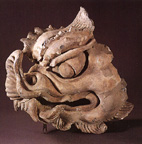
12th century CE, Liao dynasty
Earthenware
H: 56 cm
L: 55 cm
Found in the vicinity of Wanbu Huayanjing Pagoda, Huhehaote
Image courtesy of the Inner Mongolian Museum, Huhehaote (copyright reserved)
The Khitan built a number of impressive pagodas in their patronage of Buddhism, located throughout Inner Mongolia. The most prominent of these monuments is the seven-storied Wanbu Huayanjing Pagoda, colloquially known as the White Pagoda, or Baita in Chinese. The pagoda was rebuilt in recent centuries, and the only original aspects of the structure that remain are inscriptions written on the interior walls in a number of languages, including Chinese, Mongolian, Tibetan, and Khitan, the earliest dating to 1172. Written records tell us the pagoda was repaired in 1167 under the Jin dynasty, and so we know the original must have been built sometime prior to this.1
This head of some unknown fantastic creature was discovered on the grounds surrounding the White Pagoda in 1983, when repairs were being undertaken on the structure.2 The figure was originally used as architectural ornament, and while a number of other such design elements were discovered along with it, this dragon head is among the most impressive. Where it may have been originally located on the pagoda is not known, though experts speculate that adornments such as these may have been placed on the eave ends of the structure.3 The head demonstrates an interesting mix between a Chinese dragon and a fantastic creature known as a makura, which is often incorporated into Buddhist architecture in India, the Himalayas and Southeast Asia. A sinified version of the motif may have passed into territories controlled by the Liao dynasty through Central Asia.
(1) Adam T. Kessler, Empires Beyond the Great Wall: The Heritage of Genghis Khan (Los Angeles: Natural History Museum of Los Angeles County, 1993), p. 112.
(2) Ibid, p. 113.
(3) Ibid.